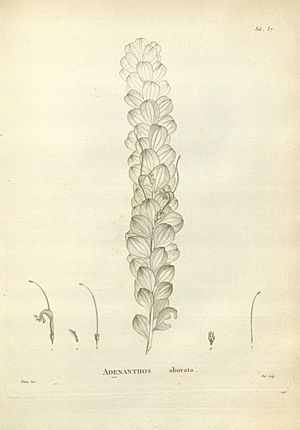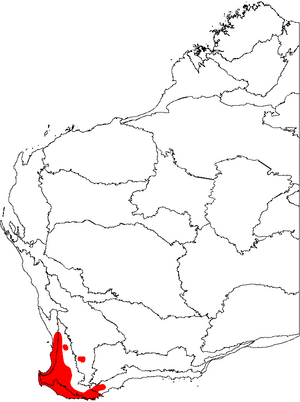Basket flower facts for kids
Quick facts for kids Basket flower |
|
|---|---|
 |
|
| Scientific classification | |
| Genus: |
Adenanthos
|
| Species: |
obovatus
|
The Adenanthos obovatus, also known as basket flower or jugflower, is a type of shrub. It belongs to the plant family called Proteaceae. This plant is special because it only grows in Southwest Australia.
A French scientist named Jacques Labillardière first described this plant in 1805. But it was actually collected earlier, in 1791, by Archibald Menzies. The A. obovatus is part of a group called Eurylaema within the Adenanthos genus. It's most closely related to the A. barbiger. Sometimes, A. obovatus mixes with another plant, A. detmoldii, to create a new plant called A. × pamela.
This shrub usually grows as a bushy plant with many stems. It can reach about 1 meter (3 feet) tall and 1.5 meters (5 feet) wide. It has fine, bright green leaves. Its pretty red or orange flowers appear from April to December, with the most flowers blooming in spring (August to October).
You can find this plant growing in sandy soils. It likes areas that are wet sometimes, like lowlands, but also hills and sand dunes. After a bushfire, it can grow back from a special underground part called a lignotuber. Birds like honeyeaters, especially the western spinebill, help pollinate its flowers. The silvereye also drinks nectar from it. The Adenanthos obovatus is a popular plant to grow in gardens in Australia because it flowers for a long time and attracts honeyeaters. It's also harvested for the cut flower industry.
Contents
What it Looks Like
The Adenanthos obovatus is a lignotuberous shrub. This means it has many stems that grow from a single underground woody base. It usually grows to be about 1 meter (3 feet) tall and 1.5 meters (5 feet) wide. Sometimes, it can even grow up to 2 meters (6.5 feet) tall.
Its leaves are bright green and shaped like an oval. They are about 20 millimeters (0.8 inches) long and 15 millimeters (0.6 inches) wide. The leaves grow directly on the branches in a spiral pattern. The flowers are red or orange and appear steadily from April to December, with the most flowers seen from August to October. They grow from where the leaves meet the stem. Usually, there's one flower per spot, but sometimes there are two.
Like other plants in the Proteaceae family, each flower has four parts that are joined together, and a single style. In A. obovatus, the flower parts are about 25 millimeters (1 inch) long, and the style is about 40 millimeters (1.6 inches) long. Even though it flowers for many months, there are usually only a few flowers open at any one time.
This plant looks very similar to A. barbiger. The main difference is usually the shape of their leaves. A. barbiger often has much longer and narrower leaves. However, some A. barbiger plants have leaves that look just like A. obovatus. Scientists can tell them apart by looking closely at the flower parts, the small leaf-like structures called bracts, and the tips of the styles. A. barbiger flowers are usually bright red, while A. obovatus flowers can be scarlet to orange.
Plant Names and History
Discovery and How it Got its Name
The first time a scientist collected a sample of A. obovatus was in 1791. This was done by a Scottish surgeon and naturalist named Archibald Menzies. He found it during the Vancouver Expedition in a place called King George Sound. However, his discovery wasn't published right away.
Later, in 1801, another Scottish botanist, Robert Brown, also collected specimens there. Then, in 1802, Jean Baptiste Leschenault de la Tour, a botanist on Nicolas Baudin's exploration trip, collected some too. Leschenault wrote about finding a plant with "rounded leaves" that was very common by the sea. This plant was A. obovatus.
A French scientist named Jacques Labillardière officially described the species in his book Novae Hollandiae Plantarum Specimen in 1805. He named it obovata because of its egg-shaped leaves, which are wider at the top. The name comes from Latin words meaning "inverse" and "egg."
For a long time, people thought Labillardière himself had collected the plant. But it turns out he described plants from areas he never visited. This means he likely got the specimens from someone else, probably Leschenault, but didn't give them credit.
Where it Fits in the Plant Family
In 1870, a scientist named George Bentham organized the Adenanthos genus into two main groups. He put A. obovata into the group called A. sect. Eurylaema. This group includes plants with certain flower features.
Later, in the 1970s, another scientist, Ernest Charles Nelson, studied the genus more closely. His research showed that A. obovata was indeed closely related to A. barbiger and A. detmoldii. So, it stayed in the A. sect. Eurylaema group.
Because of new rules for naming plants, the name was changed from Adenanthos obovata to Adenanthos obovatus. This is because plant names ending in -anthos should be masculine.
Plant Mixes (Hybrids)
The Adenanthos obovatus can mix with A. detmoldii to create a hybrid plant called A. × pamela. This hybrid was first found in 1979 in the Scott River area. It looks like a mix of its parents: taller than A. obovatus, with longer leaves and light red flowers. These hybrid plants can even produce their own seeds.
Sometimes, A. obovatus might also mix with A. barbiger. In 1921, a plant called A. intermedia was found with leaves that looked like a mix of these two species. However, scientists later decided that A. intermedia was actually just a type of A. barbiger. But it's still possible that it's a hybrid.
Common Names
People call Adenanthos obovatus by several common names. These include basket flower, glandflower, jugflower, and stick-in-the-jug. In the King George Sound area, the Aboriginal name Cheeuk is sometimes used.
Where it Lives and Grows
The A. obovatus plant is very common and can be found in many places. It grows well in acidic soils, which means the soil is a bit sour. Like most Adenanthos species, it often grows in sandy areas where the soil has been washed clean by rain. It can also be found on gravelly sand from rocky hillsides, like in the Stirling Range. It doesn't usually grow in heavy, clay-like soils.
This plant is also one of the few Adenanthos species that can grow well in damp places. It doesn't like to be completely underwater for long periods, but it thrives in moist soils.
Because of these preferences, A. obovatus is common in the scrub and heath areas of Southwest Australia. It's also found in sedgelands, which are wet, grassy areas. You won't often find it in forests because those areas usually have different types of soil. The climate where it grows is like the Mediterranean, with good rainfall each year.
The plant grows along the coast of Southwest Australia. It stretches from Gingin north of Perth down to Augusta and east to Green Range, near Albany. It's also found in the Stirling Range and at Narrogin, which are separate areas. Scientists think these separate groups of plants might be left over from a time when the climate was wetter, and the plant grew in more places.
How it Interacts with Nature
The western spinebill (Acanthorhynchus superciliosus) is the most common bird to visit the flowers of A. obovatus. These birds have long, curved beaks that fit perfectly into the tube-shaped flowers. When they drink nectar, pollen sticks to their heads. Then, they carry this pollen to other flowers, helping the plants make seeds. Studies have shown that pollen can be carried up to 20 meters (65 feet) away! Other birds like the New Holland honeyeater and brown honeyeater also visit the flowers. The silvereye drinks nectar too, but it pokes a hole in the flower tube with its short beak.
The Adenanthos obovatus is also a source of nectar for the honey possum (Tarsipes rostratus) during winter and spring.
However, A. obovatus can get sick from a water mold called Phytophthora cinnamomi. It can also be harmed by a fungus called Armillaria luteobubalina, which attacks the roots.
Growing This Plant
Scientists describe A. obovatus as a "beautiful ornamental species." It was first grown in Great Britain in 1824 and is now the most popular Adenanthos plant grown in gardens in Australia. It flowers for most of the year and is great for attracting honeyeaters to your garden. It can grow in different climates.
You can grow new plants from cuttings taken from the current season's growth. It grows quite easily and quickly. Even though it grows in damp places in nature, in gardens it prefers soil that drains well and gets plenty of sun. It's a good idea to prune it regularly to keep it looking nice.
Wild A. obovatus flowers are collected by special pickers for the cut flower industry. These flowers are sold both locally and overseas. The long, curved stems with flowers are "excellent for picking."
Images for kids
-
Centaurea tchihatcheffii (also called Yanardöner), a special and rare knapweed found only in Turkey.
-
Yellow starthistle (C. solstitialis), a plant that can spread easily but makes good honey.
See also
 In Spanish: Centaurea para niños
In Spanish: Centaurea para niños
















